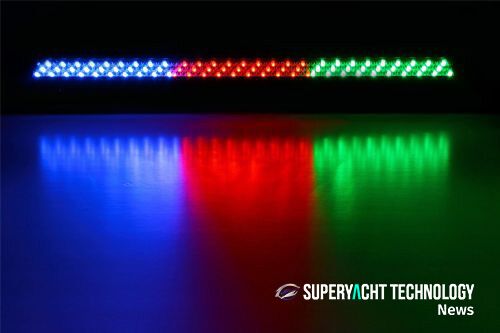Superyachts are always competing to have the best lights, and this means that I need to keep up-to-date with the latest and best lighting systems. However, recently I have been struggling to find any that are capable of meeting 2017 demands. I tend to use DMX RGB controllers because their capability to control up to 512 channels generally means they can meet the needs of extremely demanding light configurations. The ease at which you can sync multiple lights with music and pre-programme settings so they are saved for later is also very useful – one less thing to worry about when we are hosting big events onboard.
DMX controllers are traditionally considered the most reliable for RGB lighting on yachts, but they are not without their issues. One problem is that they can be susceptible to interference from nearby electronics. This makes DMX systems unsuitable for use with flammable effects such as fireworks – not an uncommon demand at yacht shows like MYS. The risk of an electrical interference setting off the explosives is just too high. Another issue is that it can be difficult to keep a strong signal going when cables are used over long distances and for intricate configurations. This can usually be sorted using repeaters, but I would love to know if there is a better way to solve it.
Indeed, cables are the root of most problems found with DMX systems. The wires get pulled about a lot leading to dry joints or broken conductors, which tend to make the moving lights and dimmers slightly erratic. Not ideal for a boat full of guests with ultra-high expectations. This makes me wonder if the solution is wireless, as much of the tech world is now. Certainly these systems would be easier to set up and in some cases cheaper. However, I worry that they are not robust enough to keep up with my needs.

For example, to use Bluetooth RGB controllers effectively the operator must be within the required radius of the system. Bluetooth 4.0 gadgets can reach a maximum distance of 200 feet, or just over 60 metres. This means that for most superyachts, users will likely experience delays or difficulty connecting if stationed at the opposite end of the yacht. Wi-Fi controls are another option if there is a wireless network covering the area, but obviously availability whilst sailing can be patchy. The success of this will also depend on the design on the boat – Wi-Fi controllers perform optimally in open environments, so yachts with thick walls or solid barriers may find their range limited.
DALI controllers are another option I have considered. DALI (Digital Addressable Lighting Interface) is generally used to control several lighting circuits in one go, and is well-suited to larger projects such as superyachts for this reason. This technology involves a LED driver linked by a two-core cable to a push-button controller at the wall. However, I have heard of people having issues where the driver has not been designed/built to a high enough spec for the demands of the owner. An inadequate LED driver cannot always translate signals into the required lighting state, meaning poor performance and sometimes even failure of either the LED or the dimmer circuitry.
I am generally reluctant to move away from DMX as it is still widely considered the best for producing colour-change and effects illumination. However, I would love any expert advice on how I can judge the best RGB lighting system controllers for different superyacht needs.

